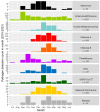Descriptive Epidemiology of Pathogens Associated with Acute Respiratory Infection in a Community-Based Study of K-12 School Children (2015-2023)
- PMID: 38668295
- PMCID: PMC11053468
- DOI: 10.3390/pathogens13040340
Descriptive Epidemiology of Pathogens Associated with Acute Respiratory Infection in a Community-Based Study of K-12 School Children (2015-2023)
Abstract
School-based outbreaks often precede increased incidence of acute respiratory infections in the greater community. We conducted acute respiratory infection surveillance among children to elucidate commonly detected pathogens in school settings and their unique characteristics and epidemiological patterns. The ORegon CHild Absenteeism due to Respiratory Disease Study (ORCHARDS) is a longitudinal, laboratory-supported, school-based, acute respiratory illness (ARI) surveillance study designed to evaluate the utility of cause-specific student absenteeism monitoring for early detection of increased activity of influenza and other respiratory viruses in schools from kindergarten through 12th grade. Eligible participants with ARIs provided demographic, epidemiologic, and symptom data, along with a nasal swab or oropharyngeal specimen. Multipathogen testing using reverse-transcription polymerase chain reaction (RT-PCR) was performed on all specimens for 18 respiratory viruses and 2 atypical bacterial pathogens (Chlamydia pneumoniae and Mycoplasma pneumoniae). Between 5 January 2015 and 9 June 2023, 3498 children participated. Pathogens were detected in 2455 of 3498 (70%) specimens. Rhinovirus/enteroviruses (36%) and influenza viruses A/B (35%) were most commonly identified in positive specimens. Rhinovirus/enteroviruses and parainfluenza viruses occurred early in the academic year, followed by seasonal coronaviruses, RSV, influenza viruses A/B, and human metapneumovirus. Since its emergence in 2020, SARS-CoV-2 was detected year-round and had a higher median age than the other pathogens. A better understanding of the etiologies, presentations, and patterns of pediatric acute respiratory infections can help inform medical and public health system responses.
Keywords: acute respiratory infection; public health; respiratory illness; respiratory viruses; school-based surveillance; surveillance.
Conflict of interest statement
The authors declare no conflicts of interest. The funders had no role in the design of the study; in the collection, analyses, or interpretation of the data; in the writing of the manuscript; or the decision to publish the results.
Figures






References
-
- McLean H.Q., Peterson S.H., King J.P., Meece J.K., Belongia E.A. School absenteeism among school-aged children with medically attended acute viral respiratory illness during three influenza seasons, 2012–2013 through 2014–2015. Influenza Other Respir. Viruses. 2017;11:220–229. doi: 10.1111/irv.12440. - DOI - PMC - PubMed
-
- Temte J.L., Barlow S., Goss M., Temte E., Bell C., He C., Hamer C., Schemmel A., Maerz B., Comp L., et al. The Oregon child absenteeism due to respiratory disease study (ORCHARDS): Rationale, objectives, and design. Influenza Other Respir. Viruses. 2022;16:340–350. doi: 10.1111/irv.12920. - DOI - PMC - PubMed
MeSH terms
Grants and funding
LinkOut - more resources
Full Text Sources
Miscellaneous

